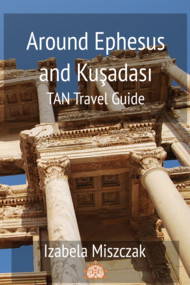This article has been previously published as a part of book Around Ephesus and Kusadasi: TAN Travel Guide by Izabela Miszczak
Lebedos was the smallest and also the least important of the twelve cities that constituted the Ionian League. Also at present the visit to the scant remains of this ancient town is not a big tourist attraction.
Historical overview:
Lebedos was, most probably, founded by the Carians, and later colonized by the Greeks who arrived there under the guidance of Andræmon, a son of Codrus. The city was inhabited from the beginning of the first millennium BC to the Byzantine times. I was never very rich or significant, because of the poor location of its harbor, which was not suitable for larger vessels. However, it was famous for its mineral springs. The development of Lebedos was also slowed down by the existence of bigger cities, Teos and Ephesus, nearby.
As a result, residents of Lebedos lived their lives in the shadow of more famous and mightier cities, as there were no well-known citizens of Lebedos, the city did not provide any ships in the naval battle with the Persians at Lade in 494 BC. What's more, Lebedos was the only city of the Ionian League that in the classical period did not mint its own coins.
What distinguished the residents of Lebedos was their extraordinary and seemingly worthy of a better cause attachment to their city. During the Hellenistic period the rulers of these lands attempted to resettle the residents Lebedos to other cities, but without success. Antigonus I Monophthalmus tried to connect Lebedos with Teos - to no avail. Apparently Lysimachus managed to resettle some of them to Ephesus, but Lebedos survived. In 266 BC it came under the control of the rulers of Egypt - the Ptolemies. From this moment for the next 60 years it was known as Ptolemais.
For a time Lebedos was the seat of so-called Artists of Dionysus. This group of the followers of the god of wine constituted of an association of actors and musicians, protected by the right of asylum in the city, where they were staying. Their artistic temperament caused conflicts with their host cities, including Teos and Ephesus. Finally, in the 2nd century BC they settled in Lebedos, where they were greeted with joy, as the inhabitants expected growth in importance and prestige of the city. The Artists of Dionysus lived in Lebedos until Mark Antony moved them to Priene.
In the Byzantine era Lebedos was the seat of the bishop until the 12th century AD. The names of three bishops of Lebedos are known: Cyriacus - the participant of the second council of Ephesus in 449 AD, Julian, and Theophanes - the participant of the Second Council of Nicaea. Currently Lebedos is the titular diocese of the Roman Catholic Church.
Archaeological research:
So far no archaeological works have been carried out in the area of Lebedos. It is believed that there was a theater for the Artists of Dionysus in the city, but its location remains a mystery.
Sightseeing:
Almost nothing has been preserved from the ancient city to our times: some fortifications on the hill, the fragments of city walls from the Hellenistic Period, which protected the city from the sea and the ruins of five watchtowers.
Lebedos is now famous for its thermal springs, which attract patients suffering from rheumatism.
Getting there:
Finding Lebedos may cause some difficulties because its ruins are so poorly preserved. Even the locals from nearby Ürkmez village know nothing about it. There are some signposts on the coastal road from Seferihisar to Selçuk. If you follow these directions you will get to small Kısık peninsula, completely covered by summer houses. From this moment there are no further signposts. If you come from Seferihisar direction to Kısık peninsula take the first turning to the right, towards the sea. After several meters you can see a sign with information that you have just arrived to Lebedos.
















